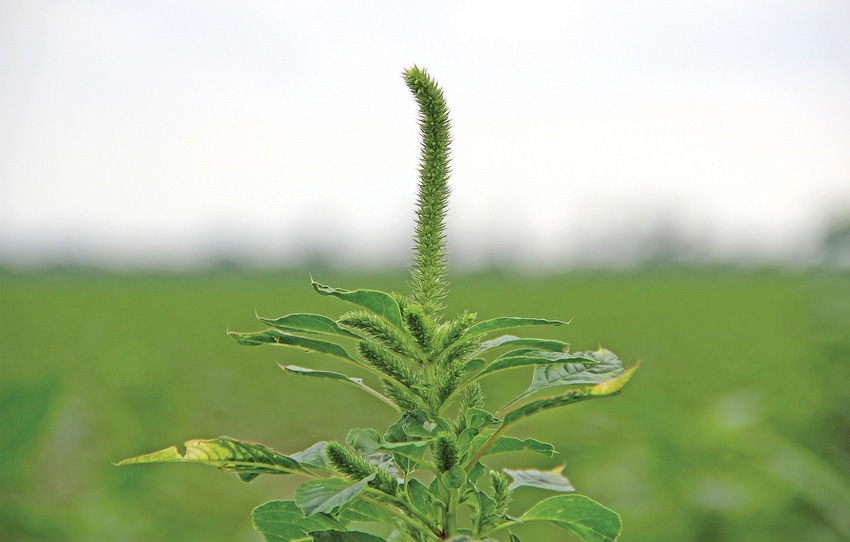
Mid-South weed scientists are cautioning dicamba-tolerant crop growers not to expect a single shot of new formulations to knock out weed populations.
As reports of pigweed escapes mount, “The main take home is: don’t spray pigweeds in your dicamba-tolerant crop once and walk away thinking all is well, especially if you have PPO resistance,” says Larry Steckel, University of Tennessee weed scientist.
PPO resistance
Be especially cautious watching for escapes in PPO-resistant pigweeds.
“Last year, we saw some escape problems in our plots around Marion and Crawfordsville where there’s PPO resistance,” says Tom Barber, University of Arkansas weed scientist. “So, what we’re hearing out of the field now is matching up well with our data.
“To me, we don’t have enough of it out yet to make many definitive statements. But there are definitely escapes happening in spots where there’s PPO resistance. We said all along a lot of those pigweed populations are harder to kill.
“We don’t know exactly why yet but there’s some type of increased metabolism to herbicides in those populations. And dicamba has been around since the 1950s so pigweeds have been able to interact with it for a long time. It’s never been a great jam-up pigweed herbicide.”
While there’s nothing definitive yet on the metabolism resistance issue, “that’s been found in Palmer (amaranth’s) cousin, waterhemp in Illinois,” says Steckel. “Regardless, we pulled some seed in Tennessee last year. A graduate student did some screening in the greenhouse in Knoxville. We found there wasn’t quite as good control with dicamba on some of the PPO-resistant pigweed. That’s similar to what the field research found in Arkansas.
“So, we’re trying to figure out if this is metabolism-based and if this is the new ‘normal.’ We’re doing more research this year to find out. It’s very early stages. We’re sending samples up to the University of Illinois because they’re ahead of us with the metabolism resistance in waterhemp.”
Spray time
A good example of escapes is a field near Snow Lake in east Arkansas. “For the first application, they sprayed Engenia at 10 gallons of water per acre,” says Robert Goodson, Phillips County Extension agent. “That didn’t provide good control. They came back with a second spray (May 15) and used 15 gallons of water.”
The second shot made the pigweeds “extremely sick. But will they die? We’re waiting to see. It isn’t a really fast process – it took us 12 days around Helena to kill pigweeds with Engenia.
“The escapes are a concern. On the other hand, there are fields that have gotten fantastic control of pigweeds with Engenia. Those were sprayed when they were small, at the right stage and they aren’t PPO-resistant.”
In the Missouri Bootheel, pigweed escapes haven’t proven to be a problem says Andrea Jones, University of Missouri cotton specialist. “Our cotton is looking great. Everything is still coming up and we’re almost 100 percent planted. Things are drying down and we’re already seeing a bit of thrips pressure.
“We’re planted so late we haven’t put the first shot of herbicide out. I’ve heard reports of pigweed escapes so we’re on the lookout. Right now, though, the cotton is just breaking through the ground at cotyledon stage.”
Back in Arkansas, Barber expects more reports of escapes to come in the week of May 22. “After one application, the pigweeds are stunted and then they start to recover after 14 days. In some instances, they’re going in with a second application. The verdict is still out on whether the second application will do the trick.
“In our plots, after two applications of dicamba we still had live pigweeds. Those weren’t the healthiest pigweed but they could still produce seed at the end of the year. Our concerns are what level of metabolism there is and how much of the pig weed population carries those traits? Given our history, we obviously don’t want to select for those populations that are harder to control.
“That’s especially worrisome in an Xtend soybean scenario because all we have to control PPO-resistant populations in Arkansas is Engenia. If we spray the pigweeds twice and don’t kill them, what then? There’s nothing else to use.”
With cotton the scenario isn’t as bleak. “We can come back in with Liberty and do a decent job cleaning up,” says Barber. “Liberty isn’t bullet-proof but at least we have more options in cotton.
“It’s still early in the growing season and we’re telling everyone using Engenia they’ll probably have to use two applications.”
Calibrating expectations
One of the problems with the new dicamba technology, says Steckel, is “the perception of what it’s capable of is ahead of what it can do. Some of the fields I’ve been to with 6-, 7-, 8-inch pigweed, the farmers are surprised they aren’t dying. Unfortunately, nobody doing weed science research is surprised at all. Those size pigweeds almost always need some kind of follow-up application.
“If you wait until your pigweeds are 4 inches tall, there are others that are 6 or 8 inches tall. Those are typically the ones that get past that first application. That’s been true and, even with the dicamba technology, it remains true.”
About the Author(s)
You May Also Like




